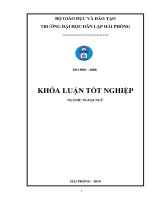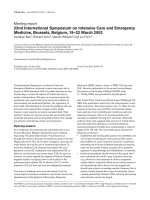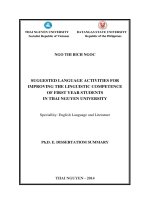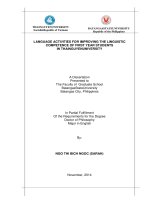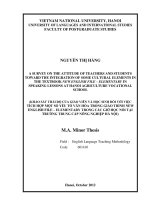A survey on the teaching of English reading skills to the first year students in mixed ability classes at Vietnam Forestry Universtiy = Khảo sát về thực trạng d
Bạn đang xem bản rút gọn của tài liệu. Xem và tải ngay bản đầy đủ của tài liệu tại đây (754.3 KB, 59 trang )
VIETNAM NATIONAL UNIVERSITY, HANOI
UNIVERSITY OF LANGUAGES AND INTERNATIONAL STUDIES
FACULTY OF POST – GRADUATE STUDIES
HỒ THỊ XUÂN HỒNG
A SURVEY ON THE TEACHING OF ENGLISH READING
SKILLS TO THE FIRST YEAR STUDENTS IN MIXED
ABILITY CLASSES AT VIETNAM FORESTRY
UNIVERSITY
(KHẢO SÁT VỀ THỰC TRẠNG DẠY KỸ NĂNG ĐỌC HIỂU CHO
SINH VIÊN NĂM THỨ NHẤT TRONG CÁC LỚP HỌC CÓ TRÌNH
ĐỘ KHÔNG ĐỒNG ĐỀU TẠI TRƯỜNG ĐẠI HỌC LÂM NGHIỆP
VIỆT NAM)
M.A Minor programme thesis
Field: English teaching methodology
Code: 60 14 10
HANOI, 2010
VIETNAM NATIONAL UNIVERSITY, HANOI
UNIVERSITY OF LANGUAGES AND INTERNATIONAL STUDIES
FACULTY OF POST – GRADUATE STUDIES
HỒ THỊ XUÂN HỒNG
A SURVEY ON THE TEACHING OF ENGLISH READING
SKILLS TO THE FIRST YEAR STUDENTS IN MIXED
ABILITY CLASSES AT VIETNAM FORESTRY
UNIVERSITY
(KHẢO SÁT VỀ THỰC TRẠNG DẠY KỸ NĂNG ĐỌC HIỂU CHO
SINH VIÊN NĂM THỨ NHẤT TRONG CÁC LỚP HỌC CÓ TRÌNH
ĐỘ KHÔNG ĐỒNG ĐỀU TẠI TRƯỜNG ĐẠI HỌC LÂM NGHIỆP
VIỆT NAM)
M.A Minor programme thesis
Field: English teaching methodology
Code: 60 14 10
Supervisor: Lâm Thị Phúc Hân, MA
HANOI, 2010
iv
TABLE OF CONTENTS
Page
Retention and use of the thesis i
Acknowledgements ii
Abstract iii
Table of contents iv
List of abbreviations vii
List of tables and charts viii
PART A: INTRODUCTION 1
1 Rationale 1
2. Aims of the study 2
3 Scope of the study 2
4. Method of the study 2
5. Significance of the study 2
6. Organization of the study 3
PART B: DEVELOPMENT 4
CHAPTER 1: LITERATURE REVIEW 4
1.1. Theory of reading in second language teaching and learning 4
1.1.1. Definition of reading comprehension 4
1.1.2. Models of reading process 5
1.1.2.1. Bottom-up model 5
1.1.2.2. Top-down model 5
1.1.2.3. Interactive model 6
1.1.3. Features of an effective reading lesson 6
1.1.4. Reading problems and solutions 7
1.1.5. Stages of a reading lesson 8
1.1.5.1. Pre-reading stage 9
1.1.5.2. While-reading stage 9
1.1.5.3. Post-reading stage 10
1.2. Theory of mixed-ability classes 10
v
1.2.1. Definition of mixed ability classes 10
1.2.2. Benefits of mixed ability classes 10
1.2.3. Challenges of mixed ability classes 11
1.2.4. Strategies for teaching mixed ability classes 12
CHAPTER 2: RESEARCH METHODOLOGY 14
2.1. The teaching context 14
2.1.1. The learners 14
2.1.2. The teachers 15
2.1.3. The syllabus 15
2.1.4. The teaching and learning conditions 15
2.2. A survey on the teaching of English reading skills to the first year students in
mixed ability classes at VFU 16
2.2.1. Participants 16
2.2.2 Data collection instruments 16
2.2.3. Data collection procedure 17
CHAPTER 3: RESULTS AND DISCUSSION 18
3.1. Results and discussion 18
3.1.1. Students’ and teachers’ attitudes toward learning and teaching English reading skills 18
3.1.2. Difficulties in teaching reading texts 20
3.1.3. Techniques in teaching reading texts 22
3.1.4. Ways of classroom management 26
3.2. Summary of main findings 28
3.2.1. Advantages of teaching English reading skills to the first year students in mixed
ability classes at VFU 28
3.2.2. Disadvantages of teaching English reading skills to the first year students in mixed
ability classes at VFU 29
CHAPTER 4: IMPLICATIONS 31
4.1. Improving students’ participation in classroom activities 31
4.1.1. Having a good understanding of individual students 31
4.1.2. Clarifying learning goals to the students 31
vi
4.1.3. Making use of pair/ group work 32
4.1.4. Changing the roles while teaching 33
4.1.5. Making use of modern technology in teaching 34
4.2. Improving teaching techniques 34
4.2.1. Adjusting teaching time and efforts 35
4.2.2. Varying strategies in three stages of reading lessons 35
4.2.2.1. Before reading 35
4.2.2.2. While reading 36
4.2.2.3. After reading 38
PART C: CONCLUSION 40
1. Summary of the study 40
2. Limitations of the study 41
3. Suggestions for further study 41
REFERENCES 42
APPENDIX i
Appendix 1: Survey questionnaires i
Appendix 1.A: Survey questionnaires for students i
Appendix 1.B: Survey questionnaires for teachers ix
Appendix 2: Sample reading texts xvii
vii
LIST OF ABBREVIATIONS
VFU: Vietnam Forestry University
ESP: English for specific purposes
MAC: Mixed ability classes
ESL: English as second language
LIST OF TABLES AND CHARTS
viii
Table 1: The frequency of difficulties in teaching reading texts
Table 2: The frequency of pre-reading activities
Table 3: The frequency of while-reading exercises
Table 4: The frequency of post-reading activities
Table 5: The frequency of grouping students with same or mixed ability
Chart 1: The importance of reading in comparison with other language skills
Chart 2: The importance of developing reading skills to the first year students in VFU
Chart 3: The main purpose of teaching reading skills to the first year students at VFU
Chart 4: Opinion about reading texts in the textbook
Chart 5: The frequency of other difficulties faced by the teachers when teaching reading in MAC
Chart 6: Ways of reading to find the main idea of the text
Chart 7: Ways of reading to find specific information of the text
Chart 8: Frequency of pair/group working
Chart 9: Students' opinion about benefits of working in pairs/groups
Chart 10: Teachers' reasons for making the students work in pairs/groups
1
PART A: INTRODUCTION
1 Rationale
Like in any other countries, in the process of integrating into regional and international
economic and diplomatic development, English is now a compulsory subject in every
school in Vietnam. Both teachers and learners seem to pay greater attention to the teaching
and learning of this language. The ultimate aim is the ability to use it for communicative
purposes. To obtain this aim, however, is not an easy task because students should be able
to acquire four skills of listening, speaking, writing and reading in addition to English
grammar, pronunciation, etc. Among these areas, reading skills play an indispensable and
inseparable part in the process of teaching and learning English as it helps students enrich
their general knowledge, and support their learning of other language skills and elements.
Therefore, how to teach and learn reading is very important.
In Vietnam Forestry University (VFU), a non-language major university, the teaching and
learning of English in general and English reading skills, in particular have received a
greater deal of attention and achieved certain success because English and English reading
skills are very important for the students to read their major’s documents in English and
very useful for their job later. However, the effectiveness of teaching and learning reading
skills is still limited, especially to the first year students. This problem may be resulted
from some factors. Firstly some teachers have been accustomed to traditional teaching
methods. They often waste much of their time explaining new words and grammatical
structures for final exams instead of providing different reading strategies for different
reading tasks to develop the students’ reading skills. The text, therefore, plays as a source
of materials for language lessons instead of skill lessons. Secondly, achieving effectiveness
in teaching reading skills become more challenging when all English classes in this
university consist of a large number of students with different language learning ability.
The other reasons may come from the reading materials, syllabus and teaching and
learning conditions.
As a teacher of English in VFU for nearly four years, this situation encourages the author
to investigate the advantages as well as the disadvantages of this issue and give some
suggestions for better learning and teaching English reading skills to the first year students.
2
2. Aims of the study
The major purposes of this study are:
(1) to investigate the advantages and disadvantages of teaching English reading skills to
the first year students in mixed ability classes at VFU.
(2) to give some suggestions to make use of the advantages and overcome the
disadvantages of teaching English reading skills to the first year students in mixed ability
classes at VFU?
These objectives will be achieved by finding the answers to the three following questions:
(1). What are the advantages of teaching English reading skills to the first year students in
mixed ability classes at VFU?
(2) What are the disadvantages of teaching English reading skills to the first year students
in mixed ability classes at VFU?
(3) What should be done to make use of the advantages and overcome the disadvantages of
teaching English reading skills to the first year students in mixed ability classes at VFU?
3 Scope of the study
The study investigates the current situation of the teaching of English reading skills to the
1
st
year students in MAC at Vietnam Forestry University.
4. Method of the study
To achieve the aims mentioned above, the quantitative approach which involves survey
questionnaires is employed to collect data for the study. The survey questionnaires are
administered to both teachers and students. The results obtained from the teachers will be
compared with those from the students for more reliable data.
5. Significance of the study
This study can, hopefully, be useful for the teachers and students in VFU as well the
researchers who have interest in this field. Once successfully completed, the study will
manage to provide a picture of teaching English reading skills to the first year VFU
students. Through the findings of the study, some suggestions will be given with a hope to
take the advantages of the strengths and overcome the weaknesses to help the first year
students in VFU improve their reading skills. Furthermore, this study can offer various and
3
useful references for further studies. It can also be an idea that attracts other researchers to
go further.
6. Organization of the study
The study consists of three main parts:
Part A is the introduction which states the rationale, aims, scope, method, significance and
organization of the study
Part B is the development which consists of 4 chapters:
Chapter 1, which serves as a theoretical and methodological foundation of the
study reviews the literature relevant to the topic.
Chapter 2 presents the research methodology.
Chapter 3 refers to the results and discussion of the survey in addition to the
summary of the main findings.
Chapter 5 is the implications which include some suggestions for better teaching
and learning reading to the first year students in MAC in VFU.
Part C is the conclusion that summarizes what has been done through the study, presents
the limitations and gives some suggestions for further researches.


